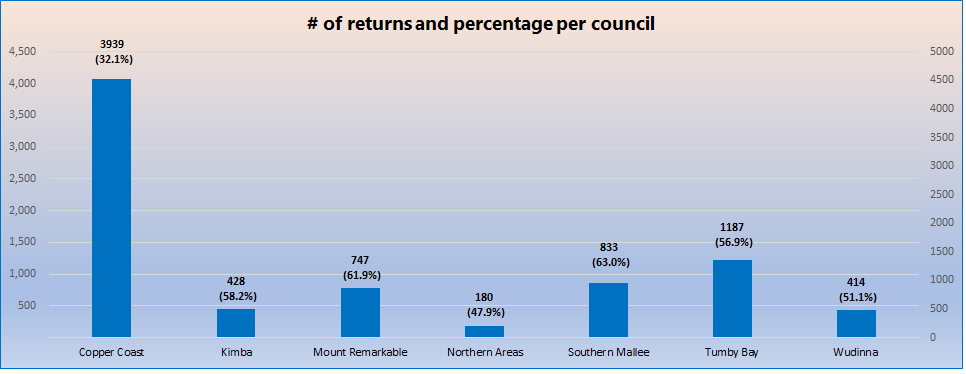Mount Barker District Council - South Ward Councillor - 2 May 2023
The resignation of a serving councillor resulted in a South Ward councillor position being vacated.
Section 6A of the Local Government (Elections) Act 1999 was applied to fill this vacancy.
The candidates who were not elected in the November 2022 periodic elections were asked to confirm their willingness and eligibility to be elected to this vacancy. As 2 candidates were determined willing and eligible to be elected to the vacancy, a recount of the votes cast at the periodic elections was conducted.
First preference votes
First preference votes were distributed to the 2 eligible candidates, and ballot papers with no preference expressed for an eligible candidate were recorded as exhausted. Below are the first preference votes received by the candidates in the order they appeared on the ballot paper.
| Candidate | First preference votes |
|---|---|
| VOOGT, Rowan Roy | 1,555 |
| HANKIN, Bill | 1,090 |
| Exhausted | 516 |
| TOTAL | 3,161 |
Distribution of preferences
 |
After the distribution of preferences, Rowan Roy VOOGT obtained 1,555 votes and was declared elected to the vacancy on 5 May 2023. |
Clare & Gilbert Valleys Council - Area Councillor - 12 April 2023
The resignation of a serving area councillor resulted in an area councillor position being vacated.
Section 6A of the Local Government (Elections) Act 1999 was applied to fill this vacancy.
The candidate who was not elected in the November 2022 periodic elections was asked to confirm their willingness and eligibility to be elected to this vacancy. It was determined the candidate was willing and eligible.
 |
Therefore, Owen PERRY was declared elected to the vacancy on 12 April 2023. |
City of Mount Gambier - Area Councillor - 3 April 2023
The election of a serving area councillor to the SA Legislative Council resulted in an area councillor position being vacated.
Section 6A of the Local Government (Elections) Act 1999 was applied to fill this vacancy.
The candidates who were not elected in the November 2022 periodic elections were asked to confirm their willingness and eligibility to be elected to this vacancy. As 5 candidates were determined willing and eligible to be elected to the vacancy, a recount of the votes cast at the periodic elections was conducted.
First preference votes
First preference votes were distributed to the 5 eligible candidates, and ballot papers with no preference expressed for an eligible candidate were recorded as exhausted. Below are the first preference votes received by the candidates in the order they appeared on the ballot paper.
| Candidate | First preference votes |
|---|---|
| TURNER, Scott | 408 |
| HERRMANN, Alysha | 1,751 |
| VIRGO, Jason | 2,023 |
| MORALE, Bruce | 1,282 |
| VON STANKE, Ian David | 1,859 |
| Exhausted | 543 |
| TOTAL | 7,866 |
Distribution of preferences
 |
After the distribution of preferences, Jason VIRGO obtained 3,051 votes and was declared elected under quota on Monday 3 April 2023. |
To view the distribution of votes refer to the City of Mount Gambier - scrutiny sheet (PDF, 135KB)
Daily returns - 2023 supplementary council elections
Total returns by council
Download the daily returns by council| Council | Vacancy | Total roll | Ballots returned | % |
| Copper Coast Council | Area councillor | 12,260 | 3,939 | 32.13 |
| District Council of Kimba | Area councillor | 735 | 428 | 58.23 |
| District Council of Mount Remarkable | Willochra ward councillor | 1,207 | 747 | 61.89 |
| Northern Areas Council | Broughton ward councillor | 376 | 180 | 47.87 |
| Southern Mallee District Council | Area councillor | 1,323 | 833 | 62.96 |
| District Council of Tumby Bay | Area councillor | 2,085 | 1,187 | 56.93 |
| Wudinna District Council | Area councillor | 810 | 414 | 51.11 |
| Grand total | 18,796 | 7,728 | 41.12 | |
| Figures as at close of business Monday 13 March 2023 | ||||

